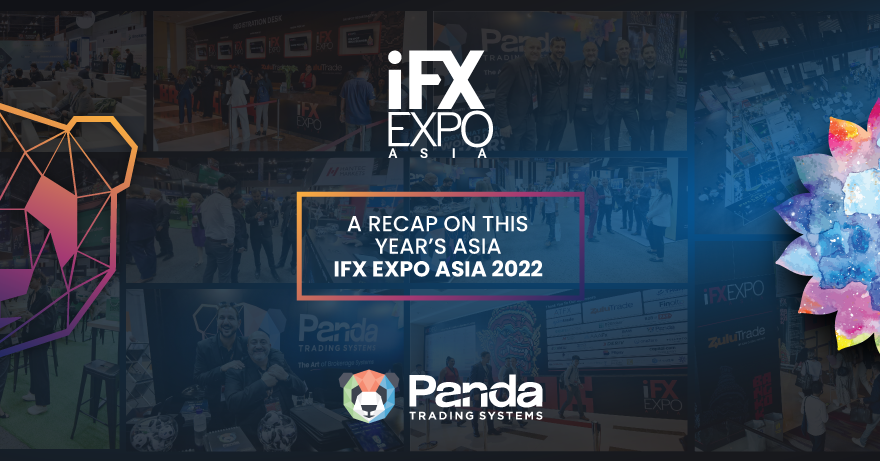
Should Brokers Replace Humans with Technology?
September 14, 2022
How to Launch a Brokerage in Just 3 Weeks
October 19, 2022
Back from this year’s exciting iFX Expo in Bangkok, we thought it would be a great opportunity to provide a recap on the event and share some of the themes and developments that we at Panda have observed from the perspective of a technology provider.
Held at the striking Centara Grand & Bangkok Convention Centre between September 13 and 15, this was the first iFX Asia Expo to be held in Thailand. Right off the bat, the new venue and inspiring surroundings of the beautiful city of Bangkok contributed a different energy to the proceedings and an excitement among both exhibitors and visitors that was palpable.
As with every iFX Expo event held in Asia, the sense of promise and potential that this region offers was massive. It’s a region that’s extremely keen on trading, one that’s eager to gain access to and explore markets. Not just FX, but the entire spectrum of asset classes that we now make available to our traders. There’s also an enormous contingent of beginner traders in the region wanting to get involved and searching for any means to simplify trading enough to get a foot in the door.
Regulatory Harmonisation Leading to Growth
One of the main takeaways of this year’s Asia Expo is that the harmonisation that has taken place across the regulatory landscape between the UK, Europe, and Australia has led a lot of businesses to view the East as highly fertile ground for future growth.
In the past, Australia would have been the main benefactor of the UK and EU harmonising their respective regulations. However, as ASIC’s regulatory guidelines have largely moved in line with those of the UK and European regions, brokers wishing to both set up in a looser jurisdiction, and gain access to the thriving trading communities in the region, now view the East as the next big thing.
The demand for lower margin requirements among traders is not a new phenomenon, but as it becomes harder to offer this in the APAC region in a regulated environment, brokers are increasingly turning further East.
Mobile is Huge but Underserved
Another theme that arose repeatedly in our discussions with brokers was the large number of companies out there with an MT4/MT5 setup, but without a mobile app. Some of these issues stem from Apple’s recent decision to remove MT4 and MT5 from their App Store, but we’ve observed that this also a much longer-running problem that originates with a number of shortcomings of the incumbent apps that we at Panda have been drawing attention to and have been working to solve for quite some time.
These include: issues of differentiation, outdated user interfaces, being shackled to the existing trading logic of these apps and their development roadmap. Perhaps most importantly, not being able to use the app as a “one-stop-shop,” having to navigate away to the broker’s own client portal for registration, verification, funding, account management and so on.
Great Interest in Simplified Trading
The most prevalent trend we’ve observed is that the growing interest in simplified/gamified trading products continues to grow unabated. This is a huge potential market in the region and beyond, touching, as it does, two different but related segments.
The first is beginners who require a scaled-down trading interface and simplified version of CFD trading in order to initially get to grips with the product. In our experience, being able to provide a simplified interface has also been a tremendous conversion tool for the brokers that make this available to their clients.
The second segment is related to potential clients who aren’t as interested in moving on to fully-functional CFD trading platforms, but rather, whose interests lie more with the gamification aspect of simplified trading products.
While there is some overlap between the above two segments, they really ought to be regarded (and indeed marketed to) as distinct groups, because their reasons for engaging in trading are fundamentally different from each other. Both, however, have the potential to generate massive volumes for their brokers and this is why we spent so much time at the expo discussing and presenting our own Simplex product.
Introducing Simplex
Simplex offers brokers the ability to provide their clients with something that looks and feels like a full version of CFD trading, but with the trickiest parts cut out and radically simplified. So, they get a full asset chart with price action history and timeframes, as they might expect, but the difference comes in when trying to place an order.
Most of the issues newcomers have actually take place in the order window, rather than the chart. In fact, even complete beginners are able to get to grips with a price chart nowadays. It’s all in the positioning, margin requirements, stop loss and take profit levels where things get confusing and where a lot of the drop-offs occur.
With Simplex, we’ve done away with customers having to calculate and worry about lot sizes. So, when placing an order, all the client has to do is select the amount they want to invest in the specific trade & the risk they are willing to bare, then the trade size and pip value is calculated for them automatically.
This method also effectively acts as an automatic stop loss, because the investment amount selected by the client is also the maximum amount they can possibly lose. There’s no way for the trade to go further against them and start eating into the rest of their account balance as in the case of regular CFD trading.
Simplex also handles take profit levels in quite an innovative way, with the client selecting a desired “payout multiplier.” This effectively sets the level (and automatically calculates it in pips) at which the trade is to be closed-out at a profit. There is also the option to reverse the trade in question, or hedge against it. The product was met with a great deal of interest at the expo, and we believe it to be a terrific match for the specific region.
Some Final Thoughts
The past few years have seen underlying markets that may not have been ideal for FX brokers specifically. While we did see some FX volatility during the pandemic as the risk-off moment saw a rush to the safe-haven of the US dollar. When people’s worst fears abated and economies began opening up, the dollar rally subsided and we saw a two year long bull market (and bubble) in risk assets, namely US stocks and crypto.
2022 has seen the undoing of all of those speculative positions as central banks around the world rush to tighten their respective monetary policies to head off the inflation caused in the wake of the pandemic.
This has been the year of FX, with great volatility and moves in major currencies like the pound sterling and the Japanese yen that we haven’t seen for many decades. The return of volatility to the FX space is a great opportunity for brokers. In our view, now is the time to secure your foundations, get your platforms in order, upgrade your systems, and introduce a new generation of traders to the largest and most exciting asset class in the world.
For free consultation
Request a Call
